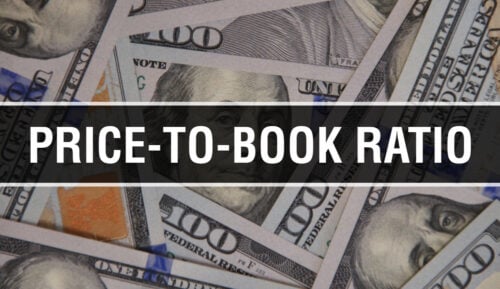Value stocks offer a unique foray into the world of investing. But what are value stocks, and how can you capitalize on them? In this article, we’ll cover everything about value stocks and then some.
What Is a Value Stock?
A value stock is a company share that’s trading for a lower price than both its business model and financial performance indicate it’s worth. Anyone buying into value stocks believes the price will rise over time to meet its expected share price.
There are some key indicators that you can use to pinpoint a value stock, which we will get into shortly.

What Is an Example of a Value Stock?
Target Corporation (NYSE: TGT) is an example of a value stock. The company is one of the largest retailers in the United States, with over $110 billion in market value.
Indicators point to a stock price lower than expected for a company with impressive sales and momentum for growth.
How to Find a Value Stock?
A value stock can reveal itself through careful market data research. In addition to a low share price, there are several ways to value potential assets that may or may not be worth trading.
Many investors use numbers to look beyond the surface and peer into a company’s financial situation.
Let’s take a look at these figures now.
P/E Ratio
A company’s price-to-earnings ratio reveals how its current share price stands in comparison to its earnings per share.
Looking at a P/E ratio helps investors identify whether a particular stock is overvalued or undervalued. Generally speaking, a lower price-to-earnings ratio reflects a company whose share price is closer to the amount it earns per share.

In many ways, the ratio suggests the amount of time it will take to recoup your investment. A P/E ratio of 12 implies it would take 12 years to earn back what you put in if the company stayed exactly as it was.
Companies with strong business fundamentals are likely to grow in time, increasing the share price and generating earnings that much faster. Not all low P/E ratios are good, as some represent companies without a solid foundation that will only lose standing over time.
The best P/E ratios are lower than competitor stocks but still have that path to growth.
PEG Ratio
A PEG ratio takes things one step further, factoring in earnings growth as well.
Where the P/E ratio doesn’t reveal a company’s growth rate, the PEG ratio offers a fuller picture of a stock’s value by looking at current earnings and potential growth.
Any stock with a PEG less than 1 is likely undervalued due to a low share price against growth potential.
On the contrary, any number over 1 probably reveals an overvalued stock.
P/B Ratio
The price-to-book (P/B) ratio looks at a stock’s value by comparing its market price to book value. Book value refers to a company’s assets minus any liabilities it may have, a representation of net worth.

Alongside the PEG ratio, a P/B value less than 1 may indicate a stock is undervalued. This number can help identify shares with inconsistent earnings from month to month.
Debt to Equity Ratio
A business’s debt-to-equity ratio showcases how well a company handles its debt by comparing it to shareholder equity.
Debt covers both short and long-term borrowing, whereas shareholder equity contains funds raised over time. Companies should not tip the scales too far one way or the other or rely too much on debt or equity to make ends meet.
Top value stocks should balance debt and shareholder equity well, with a ratio closer to 1.
Intrinsic Value
Intrinsic value shows what the average investor is willing to pay for a particular asset. Going beyond rigid formulas, intrinsic value is a perceived stock price based on business practices and potential for growth.
When a stock’s current market rate falls below its intrinsic value, investors typically see an opportunity to buy.
Dividend Yield
A dividend yield is a company’s way of giving back a portion of its income to shareholders. Businesses able to maintain a dividend yield show they have enough spare funds each quarter to reward investors.
Savvy investors study long-term changes in dividend yield, citing concerns if the percentage drops or remains static.

Companies in good standing should see dividends increase over time, whether stock prices reflect growth or not. That said, paying out a dividend yield is no guarantee of a company in good standing and in no way indicates future results.
Anyone considering such stocks will still want to look at the business’s core model before investing.
What Is a Value Trap?
Alas, value investing isn’t as easy as looking for stocks trading with lower-than-average ratios. There are instances where apparent value stocks have all the right indications to be solid investments.
However, investors fall into a value trap when the stock continues to struggle or drops even further after buying in.
The Low Multiple Value Trap
Multiples, another term for the ratios commonly used to indicate a value stock, can be misleading.
Companies can check all the right boxes, trading at low multiples of book value or earnings. When seeing these low multiples for extended periods, red flags begin to rise.

Usually, continuous trading at these low values is a sign that the stock has a poor future outlook with no path to growth. While multiples can point to a value stock, investors need to look beyond the numbers at past performance and the company’s financial goals.
Lack of Catalysts
When searching for value stock investments, be sure to look beyond the numbers and identify what a company has brewing.
Companies use catalysts to break out of the mold and grow to new heights, such as a new product, innovation, or business strategy. Any business settling on past performance probably doesn’t have the tools to keep up with others in the same industry.
Similarly, don’t hesitate to visit the company’s history and see how it has built financials over time. There should be a clear trail connecting market growth to key developments resulting in increased sales or other metrics.
Small Floats
Floats, or the number of shares a company has publicly available, can also be an indication of a value trap.
In most cases, investors want to grab from stocks with large available quantities on the market. Companies with low floats don’t have many shares to trade, making it potentially difficult to both buy and sell significant amounts.
This is a huge turn-off for institutions looking to move around stocks quickly. Shares not moving because of small floats can end up as another value trap, even if the company shows favorable financials.
Value Stock vs Growth Stock
Investors look across the broader market for different types of stocks to trade. Those with sights set on the long term tend to lean toward value or growth stocks.
While both stock types have potential, there are fundamental differences between the two.

Growth Stocks
Growth stocks trade at a reasonable price or may be overvalued on the market, but have the ability to generate better-than-average returns over time.
A growth stock can exist as anything from a small- to large-cap company, standing out among the competition for its financial and business position. As some of these organizations are still finding themselves, traders may not see a dividend yield for passive income.
Even though these shares appear to be on the threshold of increase, market volatility and other factors add risk to the equation. It’s common for growth stocks to see higher P/E ratios.
Value Stocks
On the contrary, value stocks are undervalued on the stock market, trading for lower than expected. Those investing in these stocks expect the value to catch up with where analysts predict they should be.
Price to earnings is generally low, and value stocks are almost always large-cap companies with enough income to pay out dividends. As long as the stock isn’t a value trap, the risk is lower that share prices will go down instead of up as intended.
Risks Associated with Value Stocks
A value stock often comes in the form of a larger company whose shares aren’t trading for what they’re worth. As a result, these companies tend to have less volatility than smaller-cap stocks trying to find their way in a crowded market.
There are still some risks with value stocks worth pointing out.

Overpaying for a Value Stock
Investors always try to buy low and sell high, but it’s not always easy to understand where a stock is on that spectrum. When purchasing a value stock, the goal is to pick up shares when they’re the most undervalued they’re going to be.
If you wait too long and buy too close to its fair market value, you’re missing out on all the gains leading up to that point. The lower the current valuation, the less money you’ll lose in the event the stock slips further.
Falling Into a Value Trap
Value traps are stocks that look good on the outside but internally have little to stand on.
While appearing undervalued, they are, in fact, at an accurate market value and likely to decline in time.
Not Seeing the Full Picture
It’s crucial to look beyond the numbers and at the company’s underlying structure to ensure it has the ability to grow.
A value stock almost always comes from an established corporation with years of experience under its belt. It should be clear what the company has done in the past to grow and what investors can expect in the future.

Investing in a company with a checkered past could very well be a recipe for disaster.
Best Value Stocks
Target Corporation (NYSE: TGT) – Target is a massive U.S. retailer with plenty of upward momentum. The company recently increased its dividend yield and appears significantly undervalued at present.
General Motors Company (NYSE: GM) – With over 100 years of experience, General Motors has seen it all. Although share prices are low, the company is preparing for the rise of electric vehicles that may help investors remember its true worth.
Micron Technology, Inc. (NASDAQ: MU) – Micron Technology is a semiconductor manufacturer that first opened its doors way back in 1978. The company is expected to see strong growth this year to back up its history of cutting-edge innovations.
Best Value Funds/ETFs to Invest In
If you’re looking to diversify, these exchange-traded funds (ETFs) focusing on value stocks may pique your interest.
Vanguard Value ETF (NYSEARCA: VTV) – This exchange-traded fund epitomizes value investing, with 349 unique stocks across several sectors. It has a low expense ratio and a healthy 2.28% dividend.
Invesco S&P 500 Pure Value ETF (NYSEARCA: RPV) – Invesco’s pure-play value stock ETF contains 122 holdings that factor in value scores during the selection process. Investors can expect a 2.26% dividend at present from assets representing a dozen sectors.
VictoryShares US Large Cap High Dividend Volatility Wtd ETF (NASDAQ: CDL) – VictoryShares showcases an ETF of 101 holdings containing only stocks from the 500 largest corporations by market cap. Shares are well distributed among sectors and are weighted fairly evenly.
Best Value Investors
If you’re looking to start investing in value stocks or take your strategy to the next level, there’s no better place to turn than the experts.
The following individuals helped pioneer and popularize value stock trading.
Warren Buffett
Warren Buffett is currently the fifth-richest man in the world, with a net worth in the ballpark of $120 billion.
The billionaire started investing at a young age, buying a few shares of Cities Service stock. After those shares fell, Buffett held on where many investors would have sold for a loss.

Buffett only sold his shares after the value reached new heights, and he knew the stock market was his place to be. His investing strategy revolves around value stocks, and Buffett has become an expert at identifying stocks listed far below their worth.
He follows strict criteria when picking out stocks to trade, performing thorough research so he knows if the company is in a good place to succeed.
Benjamin Graham
Benjamin Graham is known as the father of value investing. The British economist was born in 1894, working for many years as a professor and investor.

During his time investing, Graham penned two books, The Intelligent Investor and Security Analysis, which are still incredible investment tools to this day. He also worked with the concept of intrinsic value and analysis of potentially undervalued stocks.
Graham even taught a young Warren Buffett about value stocks that would fuel the billionaire’s income over the next several decades.
Michael Burry
Dr. Michael Burry is an American investor who accurately predicted and profited from the subprime mortgage crisis of 2008. His foresight earned Burry a spot in Michael Lewis’s book The Big Short, later adapted into a movie, where Burry was played by Christian Bale.
Burry gives credit for his success to both Buffett and Graham, mentioning that their insights into value stocks sparked his interest in this investing style.

While Michael Burry doesn’t place restrictions on stocks to invest in, he does careful research on each company before making any type of trade. He tends to keep a balanced portfolio of 12 to 18 stocks, instead of stretching his resources too thin.
Final Thoughts: Everything About Value Stocks
Value stocks are a great alternative to growth investing, offering income opportunities through undervalued organizations. There are obvious tells to look for in the various ratios used to analyze stocks. However, numbers only tell a portion of the story.
As with any investment, it is crucial to do research on the company you’re investing in to discern that it truly does have the potential to grow.
If the value stock experts are any indication, there’s plenty of money to be made with the right strategy.
Value Stock FAQs
Should I Buy Growth or Value Stocks?
At the end of the day, long-term investors can find success with either value or growth stocks. Value stocks tend to rise to the top during periods of recession, whereas growth stocks do better when the market is strong.
Do Value Stocks Pay Dividends?
A value stock does tend to pay dividends, as corporations they represent are often well-established with income to pay back to shareholders. However, there’s no rule stating that a value stock must do so.
Are Value Stocks Risky?
All stocks carry some risk, no matter how safe an investment may seem. Value stocks tend to represent larger market caps with strong foundations, offering less overall risk than smaller businesses.
Are Value Stocks Good During Inflation?
Value stocks often fare well during periods of inflation as shares catch up to fair market value. Forecasted returns aren’t typically affected by climbing interest rates or a reduction in sales.


 Tags:
Tags:










